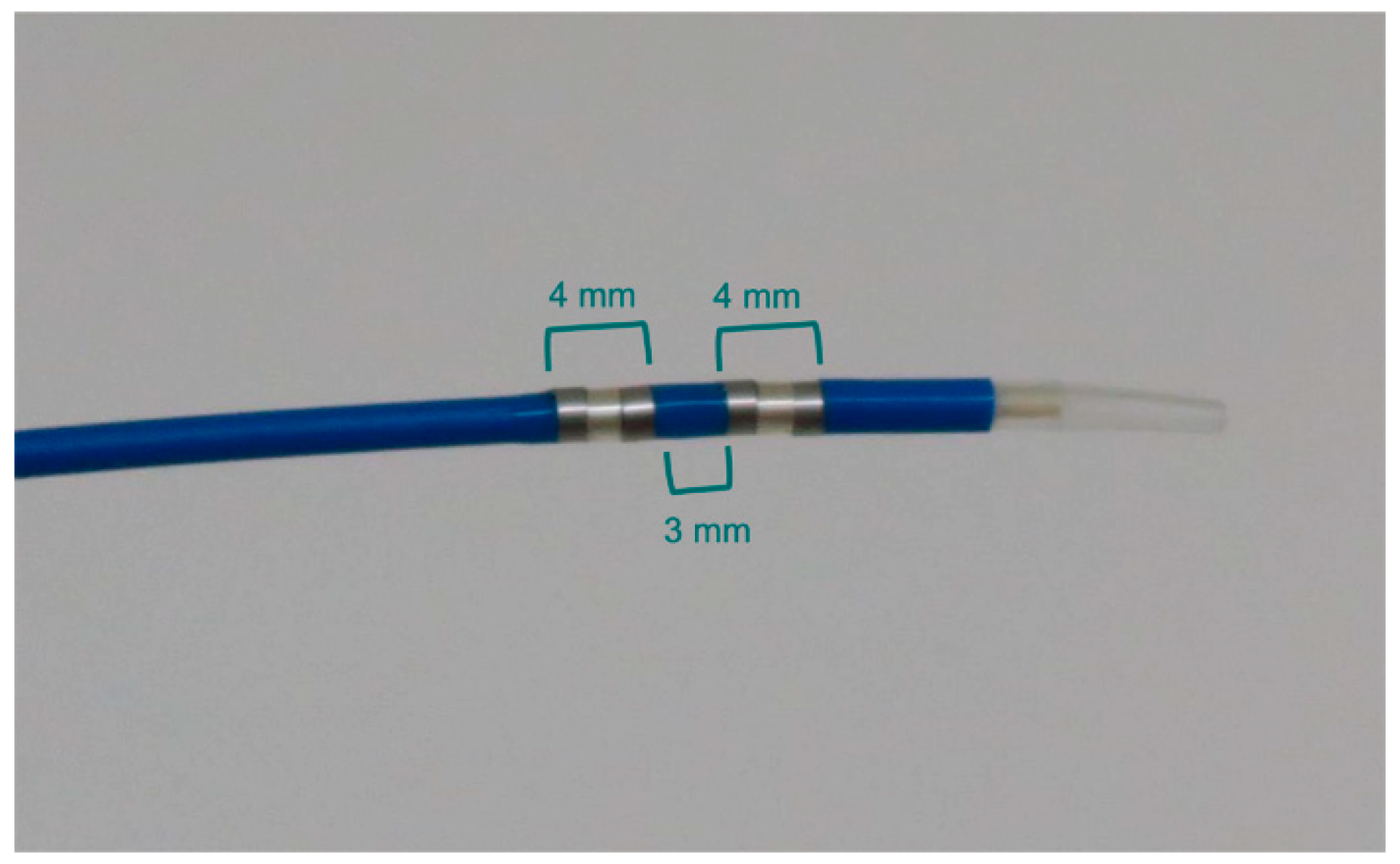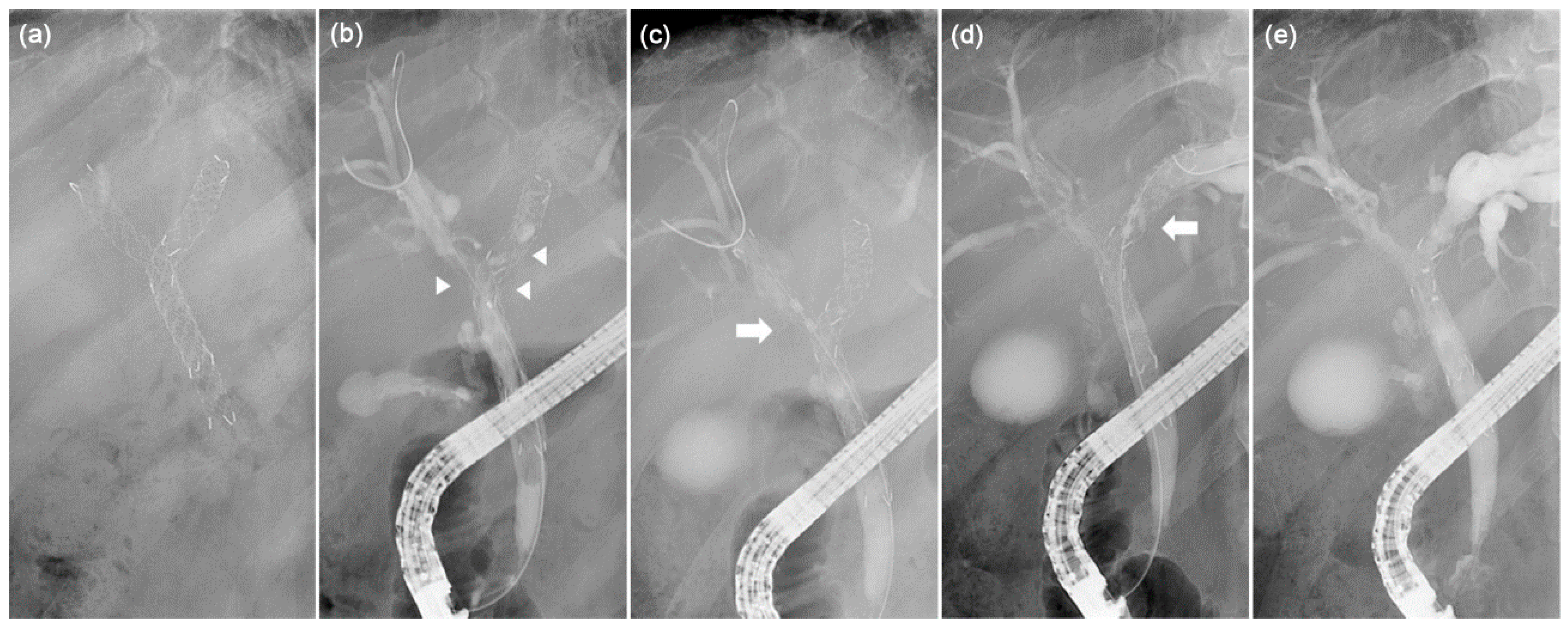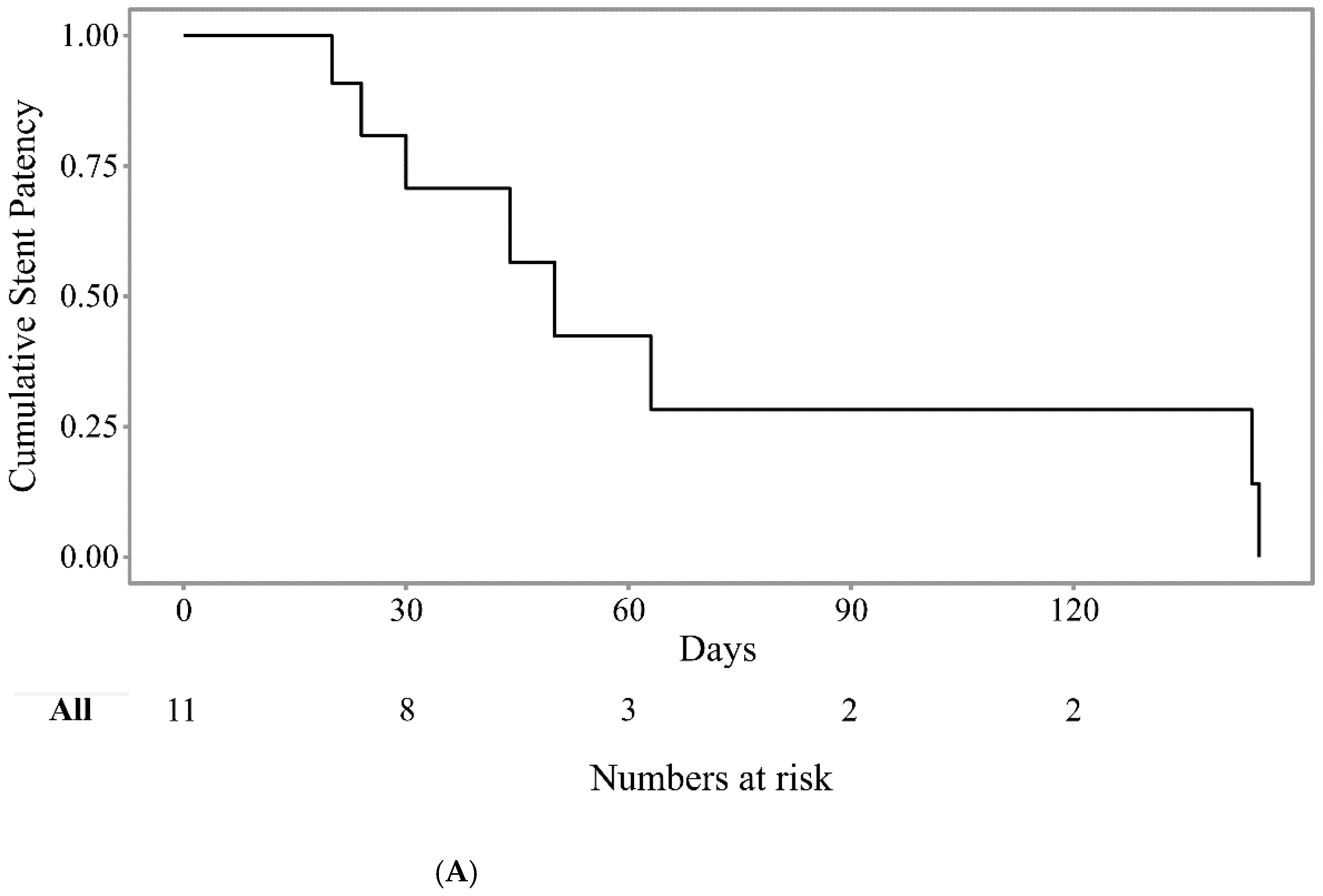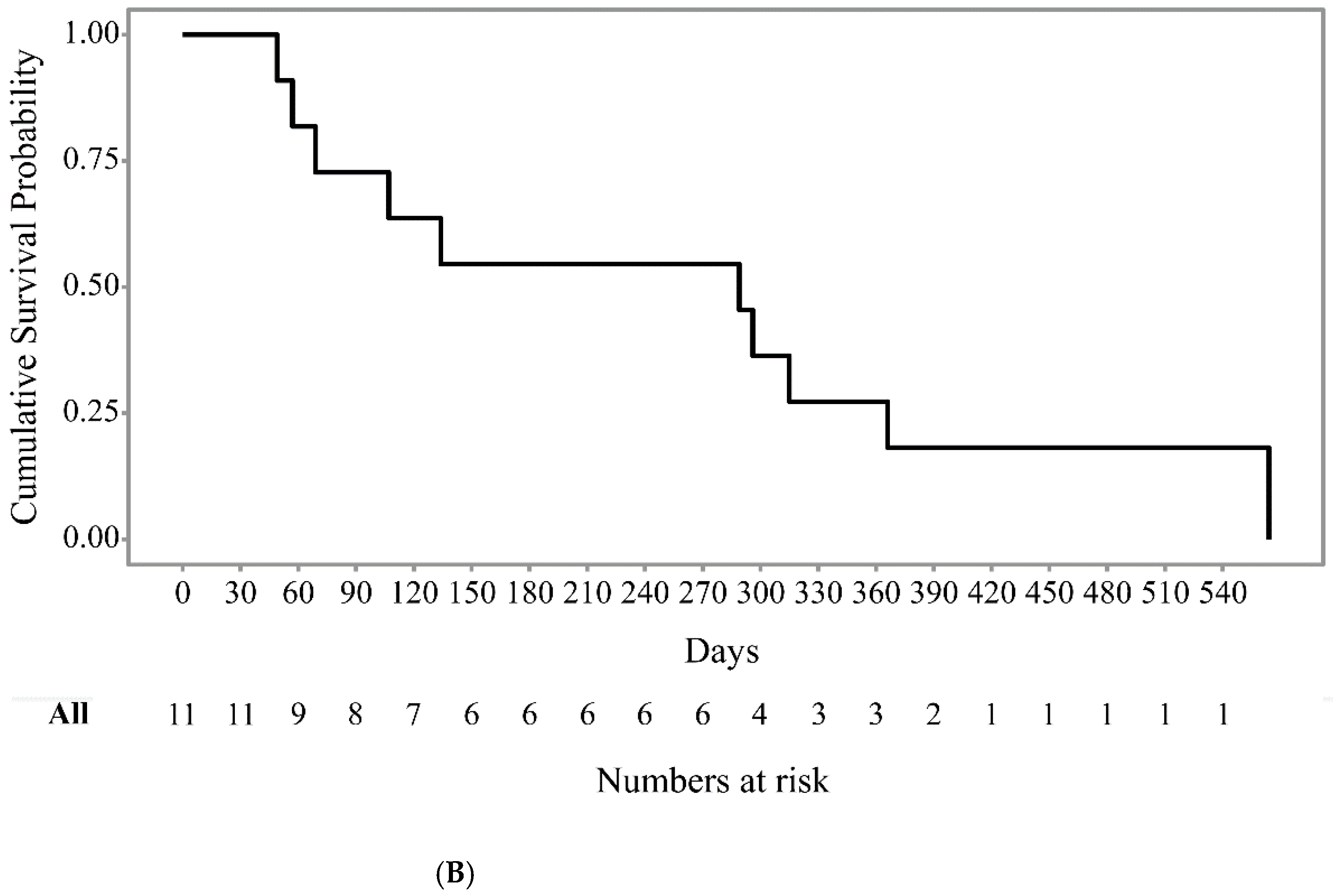Feasibility and Safety of Endoluminal Radiofrequency Ablation as a Rescue Treatment for Bilateral Metal Stent Obstruction Due to Tumor Ingrowth in the Hilum: A Pilot Study
Abstract
1. Introduction
2. Methods
Patients
3. Definitions
3.1. RFA Catheter and Power Settings
3.2. Endoluminal RFA Procedure
3.3. Post-Intervention Follow-Up
4. Results
4.1. Patient Demographics
4.2. Outcomes of Temperature-Controlled Endoluminal RFA
5. Discussion
Author Contributions
Funding
Institutional Review Board Statement
Informed Consent Statement
Data Availability Statement
Conflicts of Interest
References
- Loew, B.J.; Howell, D.A.; Sanders, M.K.; Desilets, D.J.; Kortan, P.P.; May, G.R.; Shah, R.J.; Chen, Y.K.; Parsons, W.G.; Hawes, R.H.; et al. Comparative performance of uncoated, self-expanding metal biliary stents of different designs in 2 diameters: Final results of an international multicenter, randomized, controlled trial. Gastrointest. Endosc. 2009, 70, 445–453. [Google Scholar] [CrossRef]
- Hong, W.; Sun, X.; Zhu, Q. Endoscopic stenting for malignant hilar biliary obstruction: Should it be metal or plastic and unilateral or bilateral? Eur. J. Gastroenterol. Hepatol. 2013, 25, 1105–1112. [Google Scholar] [CrossRef]
- Kaassis, M.; Boyer, J.; Dumas, R.; Ponchon, T.; Coumaros, D.; Delcenserie, R.; Canard, J.M.; Fritsch, J.; Rey, J.F.; Burtin, P. Plastic or metal stents for malignant stricture of the common bile duct? Results of a randomized prospective study. Gastrointest. Endosc. 2003, 57, 178–182. [Google Scholar] [CrossRef] [PubMed]
- Lee, T.H.; Moon, J.H.; Park, S.H. Bilateral metallic stenting in malignant hilar obstruction. Clin. Endosc. 2014, 47, 440–446. [Google Scholar] [CrossRef] [PubMed]
- Ballinger, A.B.; McHugh, M.; Catnach, S.M.; Alstead, E.M.; Clark, M.L. Symptom relief and quality of life after stenting for malignant bile duct obstruction. Gut 1994, 35, 467–470. [Google Scholar] [CrossRef]
- McCarty, T.R.; Rustagi, T. New indications for endoscopic radiofrequency ablation. Clin. Gastroenterol. Hepatol. 2018, 16, 1007–1017. [Google Scholar] [CrossRef]
- Han, K.; Ko, H.K.; Kim, K.W.; Won, H.J.; Shin, Y.M.; Kim, P.N. Radiofrequency ablation in the treatment of unresectable intrahepatic cholangiocarcinoma: Systematic review and meta-analysis. J. Vasc. Interv. Radiol. 2015, 26, 943–948. [Google Scholar] [CrossRef]
- Yang, J.; Wang, J.; Zhou, H.; Zhou, Y.; Wang, Y.; Jin, H.; Lou, Q.; Zhang, X. Efficacy and safety of endoscopic radiofrequency ablation for unresectable extrahepatic cholangiocarcinoma: A randomized trial. Endoscopy 2018, 50, 751–760. [Google Scholar] [CrossRef] [PubMed]
- Sofi, A.A.; Khan, M.A.; Das, A.; Sachdev, M.; Khuder, S.; Nawras, A.; Lee, W. Radiofrequency ablation combined with biliary stent placement versus stent placement alone for malignant biliary strictures: A systematic review and meta-analysis. Gastrointest. Endosc. 2018, 87, 944–951.e1. [Google Scholar] [CrossRef]
- Pai, M.; Valek, V.; Tomas, A.; Doros, A.; Quaretti, P.; Golfieri, R.; Mosconi, C.; Habib, N. Percutaneous intraductal radiofrequency ablation for clearance of occluded metal stent in malignant biliary obstruction: Feasibility and early results. Cardiovasc. Intervent. Radiol. 2014, 37, 235–240. [Google Scholar] [CrossRef] [PubMed]
- Kadayifci, A.; Atar, M.; Forcione, D.G.; Casey, B.W.; Kelsey, P.B.; Brugge, W.R. Radiofrequency ablation for the management of occluded biliary metal stents. Endoscopy 2016, 48, 1096–1101. [Google Scholar] [CrossRef]
- Lee, B.S.; Ryu, J.K.; Jang, D.K.; Chung, K.H.; Yoon, W.J.; Kim, J.; Woo, S.M.; Lee, S.H.; Lee, W.J.; Kim, Y.T. Reintervention for occluded metal stent in malignant bile duct obstruction: A prospective randomized trial comparing covered and uncovered metal stent. J. Gastroenterol. Hepatol. 2016, 31, 1901–1907. [Google Scholar] [CrossRef]
- Tal, A.O.; Vermehren, J.; Friedrich-Rust, M.; Bojunga, J.; Sarrazin, C.; Zeuzem, S.; Trojan, J.; Albert, J.G. Intraductal endoscopic radiofrequency ablation for the treatment of hilar non-resectable malignant bile duct obstruction. World J. Gastrointest. Endosc. 2014, 6, 13–19. [Google Scholar] [CrossRef]
- Kim, E.J.; Chung, D.H.; Kim, Y.J.; Kim, Y.S.; Park, Y.H.; Kim, K.K.; Cho, J.H. Endobiliary radiofrequency ablation for distal extrahepatic cholangiocarcinoma: A clinicopathological study. PLoS ONE 2018, 13, e0206694. [Google Scholar] [CrossRef]
- Cotton, P.B.; Eisen, G.M.; Aabakken, L.; Baron, T.H.; Hutter, M.M.; Jacobson, B.C.; Mergener, K.; Nemcek, A., Jr.; Petersen, B.T.; Petrini, J.L.; et al. A lexicon for endoscopic adverse events: Report of an asge workshop. Gastrointest. Endosc. 2010, 71, 446–454. [Google Scholar] [CrossRef] [PubMed]
- Cho, J.H.; Lee, K.H.; Kim, J.M.; Kim, Y.S.; Lee, D.H.; Jeong, S. Safety and effectiveness of endobiliary radiofrequency ablation according to the different power and target temperature in a swine model. J. Gastroenterol. Hepatol. 2017, 32, 521–526. [Google Scholar] [CrossRef] [PubMed]
- Wang, F.; Li, Q.; Zhang, X.; Jiang, G.; Ge, X.; Yu, H.; Nie, J.; Ji, G.; Miao, L. Endoscopic radiofrequency ablation for malignant biliary strictures. Exp. Ther. Med. 2016, 11, 2484–2488. [Google Scholar] [CrossRef][Green Version]
- Wu, T.T.; Li, W.M.; Li, H.C.; Ao, G.K.; Zheng, F.; Lin, H. Percutaneous intraductal radiofrequency ablation for extrahepatic distal cholangiocarcinoma: A method for prolonging stent patency and achieving better functional status and quality of life. Cardiovasc. Intervent. Radiol. 2017, 40, 260–269. [Google Scholar] [CrossRef] [PubMed]
- Alis, H.; Sengoz, C.; Gonenc, M.; Kalayci, M.U.; Kocatas, A. Endobiliary radiofrequency ablation for malignant biliary obstruction. HBPD Int. 2013, 12, 423–427. [Google Scholar] [CrossRef]
- Monga, A.; Gupta, R.; Ramchandani, M.; Rao, G.V.; Santosh, D.; Reddy, D.N. Endoscopic radiofrequency ablation of cholangiocarcinoma: New palliative treatment modality (with videos). Gastrointest. Endosc. 2011, 74, 935–937. [Google Scholar] [CrossRef]
- Dolak, W.; Schreiber, F.; Schwaighofer, H.; Gschwantler, M.; Plieschnegger, W.; Ziachehabi, A.; Mayer, A.; Kramer, L.; Kopecky, A.; Schrutka-Kölbl, C.; et al. Endoscopic radiofrequency ablation for malignant biliary obstruction: A nationwide retrospective study of 84 consecutive applications. Surg. Endosc. 2014, 28, 854–860. [Google Scholar] [CrossRef]
- Minami, Y.; Nishida, N.; Kudo, M. Radiofrequency ablation of liver metastasis: Potential impact on immune checkpoint inhibitor therapy. Eur. Radiol. 2019, 29, 5045–5051. [Google Scholar] [CrossRef]
- Hansler, J.; Wissniowski, T.T.; Schuppan, D.; Witte, A.; Bernatik, T.; Hahn, E.G.; Strobel, D. Activation and dramatically increased cytolytic activity of tumor specific t lymphocytes after radio-frequency ablation in patients with hepatocellular carcinoma and colorectal liver metastases. World J. Gastroenterol. 2006, 12, 3716–3721. [Google Scholar] [CrossRef]
- den Brok, M.H.; Sutmuller, R.P.; van der Voort, R.; Bennink, E.J.; Figdor, C.G.; Ruers, T.J.; Adema, G.J. In situ tumor ablation creates an antigen source for the generation of antitumor immunity. Cancer Res. 2004, 64, 4024–4029. [Google Scholar] [CrossRef]
- Schneider, T.; Hoffmann, H.; Dienemann, H.; Herpel, E.; Heussel, C.P.; Enk, A.H.; Ring, S.; Mahnke, K. Immune response after radiofrequency ablation and surgical resection in nonsmall cell lung cancer. Semin. Thorac. Cardiovasc. Surg. 2016, 28, 585–592. [Google Scholar] [CrossRef] [PubMed]
- Steel, A.W.; Postgate, A.J.; Khorsandi, S.; Nicholls, J.; Jiao, L.; Vlavianos, P.; Habib, N.; Westaby, D. Endoscopically applied radiofrequency ablation appears to be safe in the treatment of malignant biliary obstruction. Gastrointest. Endosc. 2011, 73, 149–153. [Google Scholar] [CrossRef] [PubMed]
- Tamada, K.; Ido, K.; Ueno, N.; Ichiyama, M.; Tomiyama, T.; Nishizono, T.; Wada, S.; Tano, S.; Aizawa, T.; Kimura, K. Assessment of the course and variations of the hepatic artery in bile duct cancer by intraductal ultrasonography. Gastrointest. Endosc. 1996, 44, 249–256. [Google Scholar] [CrossRef]
- Yoon, W.J.; Kim, Y.T.; Daglilar, E.S.; Mino-Kenudson, M.; Brugge, W.R. Evaluation of bipolar radiofrequency ablation for occluded self-expandable metal stents in the bile duct: In vivo and in vitro study. Endoscopy 2015, 47, 1167–1170. [Google Scholar] [CrossRef] [PubMed]
- Mensah, E.T.; Martin, J.; Topazian, M. Radiofrequency ablation for biliary malignancies. Curr. Opin. Gastroenterol. 2016, 32, 238–243. [Google Scholar] [CrossRef] [PubMed]




| Patient-Related Characteristics | Value |
|---|---|
| Median age, y | 64 (54–72) |
| Male:female | 6:5 |
| Cholangiocarcinoma a, n (%) | |
| Type II | 3 (27) |
| Type IIIa | 2 (18) |
| Type IIIb | 2 (18) |
| Type IV | 4 (37) |
| Median time from diagnosis to RFA, days | 245 (198–338.0) |
| Outcomes | n = 11 |
|---|---|
| Technical success, n (%) | 11(100) |
| Clinical success, n (%) | 8 (72.7) |
| Stent dysfunction, n (%) | 8 (72.7) |
| Stent patency, days | 50 (95% CI, 34–NA) |
| Death, n (%) | 10 (90.9) |
| Overall survival, days | 289 (95% CI, 107–NA) |
| Adverse events | |
| Intra-procedure | None |
| Post-procedure, n | |
| Abdominal pain | 1 |
Publisher’s Note: MDPI stays neutral with regard to jurisdictional claims in published maps and institutional affiliations. |
© 2021 by the authors. Licensee MDPI, Basel, Switzerland. This article is an open access article distributed under the terms and conditions of the Creative Commons Attribution (CC BY) license (http://creativecommons.org/licenses/by/4.0/).
Share and Cite
So, H.; Oh, C.H.; Song, T.J.; Lee, H.W.; Hwang, J.S.; Ko, S.W.; Oh, D.; Park, D.H.; Lee, S.S.; Seo, D.-W.; et al. Feasibility and Safety of Endoluminal Radiofrequency Ablation as a Rescue Treatment for Bilateral Metal Stent Obstruction Due to Tumor Ingrowth in the Hilum: A Pilot Study. J. Clin. Med. 2021, 10, 952. https://doi.org/10.3390/jcm10050952
So H, Oh CH, Song TJ, Lee HW, Hwang JS, Ko SW, Oh D, Park DH, Lee SS, Seo D-W, et al. Feasibility and Safety of Endoluminal Radiofrequency Ablation as a Rescue Treatment for Bilateral Metal Stent Obstruction Due to Tumor Ingrowth in the Hilum: A Pilot Study. Journal of Clinical Medicine. 2021; 10(5):952. https://doi.org/10.3390/jcm10050952
Chicago/Turabian StyleSo, Hoonsub, Chi Hyuk Oh, Tae Jun Song, Hyun Woo Lee, Jun Seong Hwang, Sung Woo Ko, Dongwook Oh, Do Hyun Park, Sang Soo Lee, Dong-Wan Seo, and et al. 2021. "Feasibility and Safety of Endoluminal Radiofrequency Ablation as a Rescue Treatment for Bilateral Metal Stent Obstruction Due to Tumor Ingrowth in the Hilum: A Pilot Study" Journal of Clinical Medicine 10, no. 5: 952. https://doi.org/10.3390/jcm10050952
APA StyleSo, H., Oh, C. H., Song, T. J., Lee, H. W., Hwang, J. S., Ko, S. W., Oh, D., Park, D. H., Lee, S. S., Seo, D.-W., Lee, S. K., & Kim, M.-H. (2021). Feasibility and Safety of Endoluminal Radiofrequency Ablation as a Rescue Treatment for Bilateral Metal Stent Obstruction Due to Tumor Ingrowth in the Hilum: A Pilot Study. Journal of Clinical Medicine, 10(5), 952. https://doi.org/10.3390/jcm10050952







